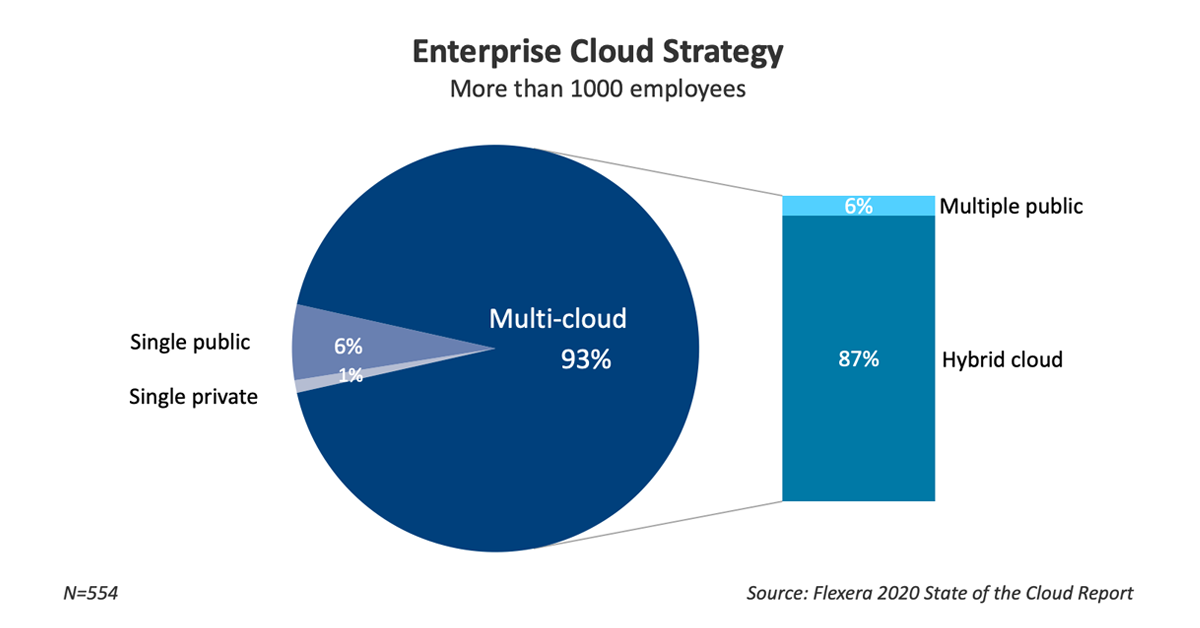Considerations for multicloud adoption in enterprises
Introduction
Cloud computing is mainstream now and it is the major driver for digital transformation in enterprises. The number of enterprises using or planning to use multiple clouds is growing. Primarily they use private cloud due to its security advantages and public cloud for innovation. There is a lot more to it when organisations choose the type of cloud which is the focus of this article. In the beginning phase of the cloud journey enterprises started adopting hybrid cloud which is a combination of on-premise and public cloud. Now it has been extended to multi-cloud which is hybrid cloud + N, N is one or more cloud providers. For example, an enterprise started using the AWS cloud along with its on-premise data centre and later extended to use the Azure cloud as well. Some of the enterprises also use multiple public clouds without an on-prem data centre.
 RightScale State of the cloud report, 2020 (source: https://info.flexera.com/)
RightScale State of the cloud report, 2020 (source: https://info.flexera.com/)
As per the RightScale State of the cloud report, 2020 around 93% of the enterprises surveyed use multiple clouds.This is a 9% increase in comparision to the data published in 2019.(The above diagram and related text is updated on August 18 2020).
1.Benefits
The following are the benefits organisations are considering while looking into a multi-cloud adoption strategy.
1.1. Reduced Vendor Lock-in
As more and more business-critical workloads are moving to cloud, enterprises are reluctant to get into single vendor lock-in. Spreading out the work amongst cloud providers are seen as a hedging strategy against vendor lock-in.
1.2 Best of Breed innovation
Different cloud providers can provide the best of breed solutions on different technologies as per the strength of innovations. So, users have choices to pick the right tool for the job.
1.3 Price Negotiation
Enterprises have better negotiation power on the pricing of cloud contracts as they are not overly reliant on any single cloud provider.
1.4 Geo-Presence
There might be a need to run different workloads in different regions for data sovereignty reasons. They may also want to run workloads in the nearest data centres to minimize latency.
1.5 QoS and SLA consideration
Organisations can choose a cloud provider’s offering out of multiple cloud providers based on their Service Level Agreement (SLA) and Quality of Service (QoS).
1.6 Workload segregation
Segregating dev/test and production workloads. Development and testing workloads can run in on-prem and the production workloads might be running in a public cloud to take advantage of latency on a local colocation region, disaster recovery, scalability, etc.
1.7 Improved disaster recovery
Multi-cloud disaster recovery is another area that has proved its mettle. Here one copy of the application runs on one cloud provider while its identical copy is ready with another provider to take over if the first copy fails due to some reason. Multi-cloud disaster recovery works well as we have seen the failures of relying on a single cloud provider over the years. This applies to organisations when unscheduled downtime would severely disrupt their business.
2. Disadvantages
2.1. Managing costs and loss of discounts
A single cloud provider always has discounts on the bulk usage of its offerings. The discounts are often directly proportional to the usage. In a multi-cloud approach, the usage spreads across cloud providers and thins down which results in bringing down the discounts.
2.2. Security
Security can never be let upon in the hands of the cloud providers. Cloud provider’s responsibility is to provide all the best tools, processes and strategies for the security of the applications, but security is always the enterprise’s responsibility. They need to incorporate Zero-trust security including least privilege access. With multiple cloud providers the scope and complexity of maintaining security increases due to an increased attack surface area for hackers.
2.3. Multi-cloud management
When enterprise workloads are spread across different clouds, they need some visibility to the usage and cost control. Multi-cloud management tools are available which can help the enterprises to get insights into their cloud usage and spending patterns.
Conclusion
The holy grail of cloud and that of multi-cloud is cost management. As of now, organisations are struggling with cloud cost controls and cloud sprawl. Cloud sprawl is running excess workloads in the cloud without the company’s knowledge. What organisations ultimately wants to achieve with a multi-cloud approach is cloud arbitrage.Cloud arbitrage is dynamically shifting workloads across clouds to leverage relative price and performance advantages. We are in the early days of cloud arbitrage.As cloud arbitrage will become more mainstream organisations will get benefitted by higher QoS(Quality of Service) levels and decreased cost.